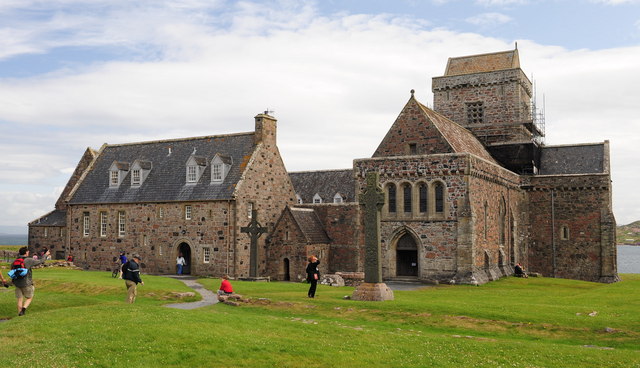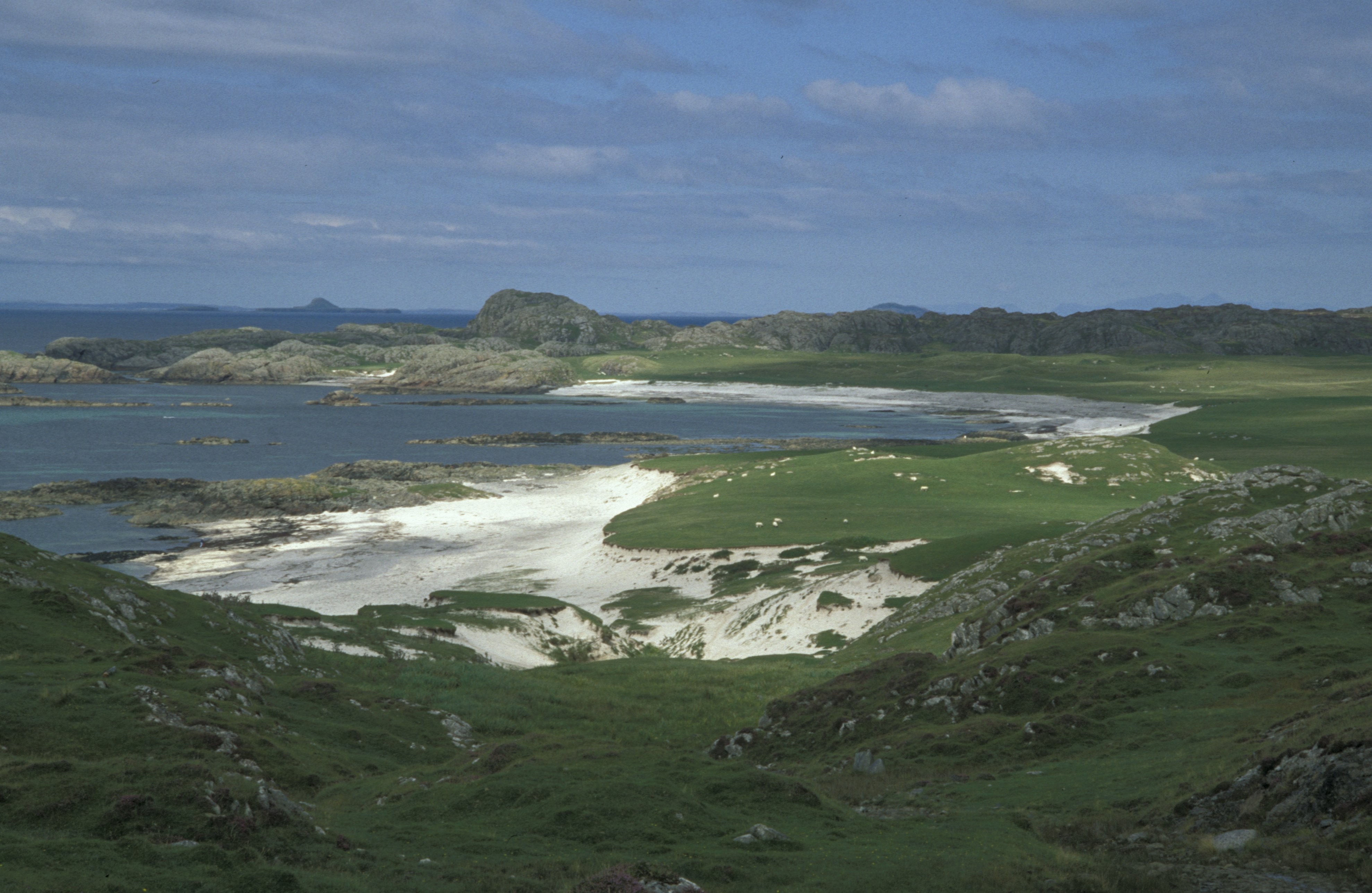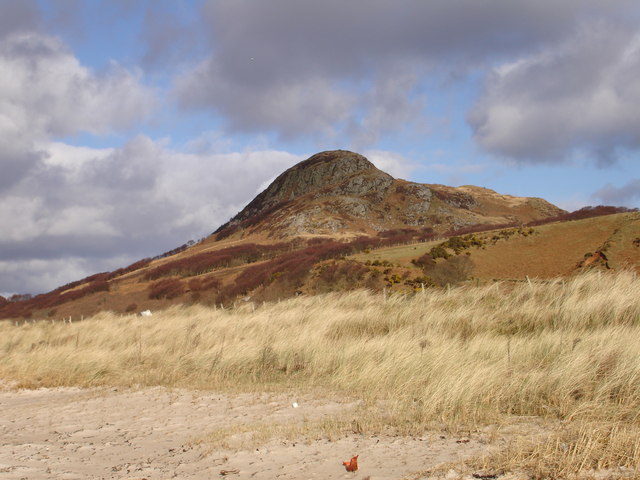|
Columba
Columba or Colmcille; gd, Calum Cille; gv, Colum Keeilley; non, Kolban or at least partly reinterpreted as (7 December 521 – 9 June 597 AD) was an Irish abbot and missionary evangelist credited with spreading Christianity in what is today Scotland at the start of the Hiberno-Scottish mission. He founded the important abbey on Iona, which became a dominant religious and political institution in the region for centuries. He is the patron saint of Derry. He was highly regarded by both the Gaels of Dál Riata and the Picts, and is remembered today as a Catholic saint and one of the Twelve Apostles of Ireland. Columba studied under some of Ireland's most prominent church figures and founded several monasteries in the country. Around 563 AD he and his twelve companions crossed to Dunaverty near Southend, Argyll, in Kintyre before settling in Iona in Scotland, then part of the Ulster kingdom of Dál Riata, where they founded a new abbey as a base for spreading Celtic ... [...More Info...] [...Related Items...] OR: [Wikipedia] [Google] [Baidu] |
Columbanus
Columbanus ( ga, Columbán; 543 – 21 November 615) was an Irish missionary notable for founding a number of monasteries after 590 in the Frankish and Lombard kingdoms, most notably Luxeuil Abbey in present-day France and Bobbio Abbey in present-day Italy. Columbanus taught an Irish monastic rule and penitential practices for those repenting of sins, which emphasised private confession to a priest, followed by penances levied by the priest in reparation for the sins. Columbanus is one of the earliest identifiable Hiberno-Latin writers. Sources Most of what we know about Columbanus is based on Columbanus' own works (as far as they have been preserved) and Jonas of Susa's ''Vita Columbani'' (''Life of Columbanus''), which was written between 639 and 641. Jonas entered Bobbio after Columbanus' death but relied on reports of monks who still knew Columbanus. A description of miracles of Columbanus written by an anonymous monk of Bobbio is of much later date.O'Hara, Alexander, ... [...More Info...] [...Related Items...] OR: [Wikipedia] [Google] [Baidu] |
Hiberno-Scottish Mission
The Hiberno-Scottish mission was a series of expeditions in the 6th and 7th centuries by Gaelic missionaries originating from Ireland that spread Celtic Christianity in Scotland, Wales, England and Merovingian France. Celtic Christianity spread first within the Kingdom of Dál Riata, within Ireland and the western coast of Scotland. Since the 8th and 9th centuries, these early missions were called 'Celtic Christianity'. There is dispute over the relationship of the Hiberno-Scottish mission to Catholic Christianity. Catholic sources claim it functioned under the authority of the Holy See, while Protestant historians highlight conflicts between Celtic and Catholic clergy. There is agreement that the mission was not strictly coordinated. Etymology ''Hibernia'' is the Latin name for the island of Ireland. The Latin term '''Scotti refers to the Gaelic-speaking people of Ireland and western Scotland. From this term, developed an alternate Latin name for the territory in which t ... [...More Info...] [...Related Items...] OR: [Wikipedia] [Google] [Baidu] |
Iona Abbey
Iona Abbey is an abbey located on the island of Iona, just off the Isle of Mull on the West Coast of Scotland. It is one of the oldest Christian religious centres in Western Europe. The abbey was a focal point for the spread of Christianity throughout Scotland and marks the foundation of a monastic community by St. Columba, when Iona was part of the Kingdom of Dál Riata. Saint Aidan served as a monk at Iona, before helping to reestablish Christianity in Northumberland, on the island of Lindisfarne. Iona Abbey is the spiritual home of the Iona Community, an ecumenical Christian religious order, whose headquarters are in Glasgow. The Abbey remains a popular site of Christian pilgrimage today. History Early history In 563, Columba came to Iona from Ireland with twelve companions, and founded a monastery. It developed as an influential centre for the spread of Christianity among the Picts and Scots. At this time the name of the island and so the abbey was "Hy" or "Hii"; "Io ... [...More Info...] [...Related Items...] OR: [Wikipedia] [Google] [Baidu] |
Celtic Christianity
Celtic Christianity ( kw, Kristoneth; cy, Cristnogaeth; gd, Crìosdaidheachd; gv, Credjue Creestee/Creestiaght; ga, Críostaíocht/Críostúlacht; br, Kristeniezh; gl, Cristianismo celta) is a form of Christianity that was common, or held to be common, across the Celtic-speaking world during the Early Middle Ages. Some writers have described a distinct Celtic Church uniting the Celtic peoples and distinguishing them from adherents of the Roman Church, while others classify Celtic Christianity as a set of distinctive practices occurring in those areas. Varying scholars reject the former notion, but note that there were certain traditions and practices present in both the Irish and British churches that were not seen in the wider Christian world. Such practices include: a distinctive system for determining the dating of Easter, a style of monastic tonsure, a unique system of penance, and the popularity of going into "exile for Christ". Additionally, there were other pr ... [...More Info...] [...Related Items...] OR: [Wikipedia] [Google] [Baidu] |
Iona
Iona (; gd, Ì Chaluim Chille (IPA: �iːˈxaɫ̪ɯimˈçiʎə, sometimes simply ''Ì''; sco, Iona) is a small island in the Inner Hebrides, off the Ross of Mull on the western coast of Scotland. It is mainly known for Iona Abbey, though there are other buildings on the island. Iona Abbey was a centre of Gaelic monasticism for three centuries and is today known for its relative tranquility and natural environment. It is a tourist destination and a place for spiritual retreats. Its modern Scottish Gaelic name means "Iona of (Saint) Columba" (formerly anglicised as "Icolmkill"). In 2019, the island's estimated population was 120. Residents engage in farming, using traditional methods. Other occupations include crofting and tourism-related work; some craftsmen make goods for sale locally, such as pottery, tapestries, jewellery and knitted goods. In March 1980, the Hugh Fraser Foundation donated much of the main island (and its off-lying islands) to the current owner, the Natio ... [...More Info...] [...Related Items...] OR: [Wikipedia] [Google] [Baidu] |
Dál Riata
Dál Riata or Dál Riada (also Dalriada) () was a Gaelic kingdom that encompassed the western seaboard of Scotland and north-eastern Ireland, on each side of the North Channel. At its height in the 6th and 7th centuries, it covered what is now Argyll ("Coast of the Gaels") in Scotland and part of County Antrim in Northern Ireland.Clancy, Thomas Owen, "Philosopher King: Nechtan mac Der Ilei," SHR 83 (2004): 135–149 After a period of expansion, Dál Riata eventually became associated with the Gaelic Kingdom of Alba.Oxford Companion to Scottish History pp. 161–162, edited by Michael Lynch, Oxford University Press. . In Argyll, it consisted of four main kindreds, each with their own chief: Cenél nGabráin (based in Kintyre), Cenél nÓengusa (based on Islay), Cenél Loairn (who gave their name to the district of Lorn) and Cenél Comgaill (who gave their name to Cowal). The hillfort of Dunadd is believed to have been its capital. Other royal forts included Dunolli ... [...More Info...] [...Related Items...] OR: [Wikipedia] [Google] [Baidu] |
Presbyterian Church
Presbyterianism is a part of the Reformed tradition within Protestantism that broke from the Roman Catholic Church in Scotland by John Knox, who was a priest at St. Giles Cathedral (Church of Scotland). Presbyterian churches derive their name from the presbyterian form of church government by representative assemblies of elders. Many Reformed churches are organised this way, but the word ''Presbyterian'', when capitalized, is often applied to churches that trace their roots to the Church of Scotland or to English Dissenter groups that formed during the English Civil War. Presbyterian theology typically emphasizes the sovereignty of God, the authority of the Scriptures, and the necessity of grace through faith in Christ. Presbyterian church government was ensured in Scotland by the Acts of Union in 1707, which created the Kingdom of Great Britain. In fact, most Presbyterians found in England can trace a Scottish connection, and the Presbyterian denomination was also t ... [...More Info...] [...Related Items...] OR: [Wikipedia] [Google] [Baidu] |
Picts
The Picts were a group of peoples who lived in what is now northern and eastern Scotland (north of the Firth of Forth) during Late Antiquity and the Early Middle Ages. Where they lived and what their culture was like can be inferred from early medieval texts and Pictish stones. Their Latin name, , appears in written records from the 3rd to the 10th century. Early medieval sources report the existence of a distinct Pictish language, which today is believed to have been an Insular Celtic language, closely related to the Brittonic spoken by the Britons who lived to the south. Picts are assumed to have been the descendants of the Caledonii and other Iron Age tribes that were mentioned by Roman historians or on the world map of Ptolemy. The Pictish kingdom, often called Pictland in modern sources, achieved a large degree of political unity in the late 7th and early 8th centuries through the expanding kingdom of Fortriu, the Iron Age Verturiones. By the year 900, the result ... [...More Info...] [...Related Items...] OR: [Wikipedia] [Google] [Baidu] |
Gartan
Gartan ( ga, Gartán) is a parish in County Donegal, Ireland. It is best known for being the birthplace of Columba, one of the three patron saints of Ireland and one of the most revered saints in the Christian world. Here he founded a monastery in 521. The popular song " Gartan Mother's Lullaby" comes from the area, and has been performed by many artists, including American actress Meryl Streep. From the book ''Kenny'', by Leona Dalrymple (The Reilly & Britton Co., Chicago, 1917): Gallery File:St Columba's church, Gartan, Donegal.jpg, The remains of St. Columba's church. File:Gartan Ráth Cnó Colm Cille 1400 Memorial Plaque 2012 09 19.jpg, Memorial plaque unveiled by Mary Robinson on the occasion of the 1400th anniversary of the death of Colm Cille Columba or Colmcille; gd, Calum Cille; gv, Colum Keeilley; non, Kolban or at least partly reinterpreted as (7 December 521 – 9 June 597 AD) was an Irish abbot and missionary evangelist credited with spreading Chri ... [...More Info...] [...Related Items...] OR: [Wikipedia] [Google] [Baidu] |
Kintyre
Kintyre ( gd, Cinn Tìre, ) is a peninsula in western Scotland, in the southwest of Argyll and Bute. The peninsula stretches about , from the Mull of Kintyre in the south to East and West Loch Tarbert in the north. The region immediately north of Kintyre is known as Knapdale. Kintyre is long and narrow, at no point more than from west coast to east coast, and is less than wide where it connects to Knapdale. The east side of the Kintyre Peninsula is bounded by Kilbrannan Sound, with a number of coastal peaks such as Torr Mor. The central spine of the peninsula is mostly hilly moorland, the highest point being Beinn an Tuirc at .Ordnance Survey. Landranger 1:50,000 Map Sheet 68 (South Kintyre & Cambeltown) The coastal areas and hinterland, however, are rich and fertile. Kintyre has long been a prized area for settlers, including the early Scots who migrated from Ulster to western Scotland and the Vikings or Norsemen who conquered and settled the area just before the start ... [...More Info...] [...Related Items...] OR: [Wikipedia] [Google] [Baidu] |
Southend, Argyll
Southend (, ) is the main settlement at the southern end of the Kintyre peninsula in Argyll and Bute, Scotland. It lies south of Campbeltown, the main town in the area. The civil parish of Southend comprises the village and the surrounding land, used mainly for farming and forestry. The population of the parish is 497. History The village is located beside Dunaverty Bay, which at one end has a rocky promontory called ''Dunaverty Rock'', where Dunaverty Castle was located. Historically the local inhabitants may be first mentioned by Ptolemy as the Epidii (horse people), whose main town may have been named later in the Ravenna Cosmography as Rauatonium. During the early medieval period Dunaverty became the location where Saint Columba first set foot in Scotland. Above the cemetery at Keil are two carved human footprints ( Petrosomatoglyphs) similar to that seen at Dunadd, now called ''Columba's Footprints''. Here it is claimed Columba first preached on Scottish soil, after ... [...More Info...] [...Related Items...] OR: [Wikipedia] [Google] [Baidu] |
Twelve Apostles Of Ireland
The Twelve Apostles of Ireland (also known as Twelve Apostles of Erin, ir, Dhá Aspal Déag na hÉireann) were twelve early Irish monastic saints of the sixth century who studied under St Finnian (d. 549) at his famous monastic school Clonard Abbey at Cluain-Eraird (Erard's Meadow), now Clonard in County Meath. History Clonard Abbey, situated on the River Boyne in modern County Meath was one of the main monastic schools in early Christian Ireland. During the 6th century, some of the most significant names in the history of Irish Christianity studied at the Clonard monastery. It is said that the average number of scholars under instruction at Clonard was 3,000. Twelve students who studied under St Finian became known as the "Twelve Apostles of Ireland". This tradition is recorded in the 17th century, possibly based on older sources. The twelve saints are grouped together as such in the text ("The Twelve Apostles of Ireland", the modern Irish being ). The text is pre ... [...More Info...] [...Related Items...] OR: [Wikipedia] [Google] [Baidu] |








